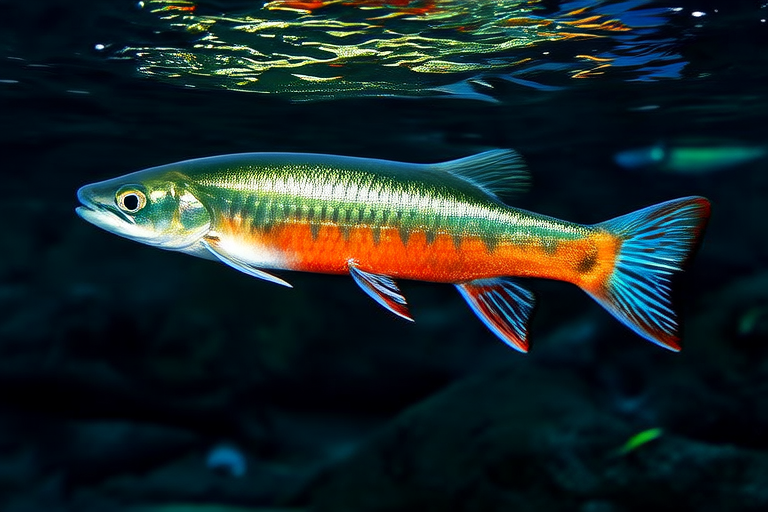Unleashing the Majesty: All You Need to Know About Rajah Cichlid
The world of freshwater aquariums is vast and diverse, offering a wide array of fish species that captivate hobbyists with their unique attributes. Among these, the Rajah Cichlid (Vicarius zenkoi) stands out as a remarkable addition due to its striking appearance and intriguing behaviors. This comprehensive guide will delve into the origins, physical characteristics, behavior, dietary needs, habitat requirements, common health issues, breeding habits, and essential tips for aquarium owners interested in keeping this majestic species.
Origin and History
The Rajah Cichlid hails from the warm waters of Lake Tanganyika in East Africa, one of the oldest and deepest lakes on Earth. This lake is renowned for its biodiversity, and the Rajah Cichlid is a testament to the evolutionary marvels that have taken place there over millions of years. Native to the rocky shores and boulder-strewn areas of the lake, this species has adapted to thrive in environments characterized by swift water currents and ample hiding spots among rocks.
Physical Characteristics
One of the most striking features of the Rajah Cichlid is its vibrant coloration. Males typically exhibit a rich, golden hue that intensifies during spawning periods, while females tend to display more subdued tones. Both sexes feature dark vertical stripes along their bodies, which serve as excellent camouflage in their natural habitat. Their elongated bodies are complemented by robust dorsal and anal fins, adding to their overall regal appearance. The eyes are large and expressive, giving them a keen predatory gaze.
Behavior
Rajah Cichlids are known for their territorial nature, particularly when it comes to defending their chosen territories within the aquarium. They can be somewhat aggressive towards conspecifics, especially if space is limited or competition for resources is high. However, they generally coexist well with other robust cichlids from similar habitats. Their natural instinct is to establish dominance through displays of fin flaring and chasing, making them fascinating subjects to observe in an aquarium setting.
Dietary Needs
As carnivorous fish, Rajah Cichlids have specific dietary requirements to maintain optimal health and vitality. In the wild, they primarily feed on small crustaceans, insect larvae, and other aquatic organisms. In captivity, it is crucial to provide a balanced diet that includes high-quality pellets designed for carnivorous fish, supplemented with occasional treats such as frozen bloodworms or brine shrimp. Ensuring a varied diet helps prevent nutritional deficiencies and supports their growth and coloration.
Habitat Requirements
Creating an environment that mimics the natural habitat of the Rajah Cichlid is essential for their well-being. An ideal setup would include a spacious tank with plenty of open swimming areas, coupled with numerous hiding spots such as rock formations and caves. Substrate should consist of fine gravel or sand, ensuring it does not damage their delicate barbels. Water parameters must be closely monitored, maintaining a pH level between 7.8 and 9.0, hardness ranging from 10 to 20 dGH, and a temperature of approximately 75-82°F (24-28°C). Regular water changes and efficient filtration systems are necessary to maintain water quality.
Common Health Issues
Like many cichlid species, Rajah Cichlids are susceptible to certain health problems if not properly cared for. One of the most prevalent issues is Ichthyophthirius multifiliis, commonly known as Ich, which manifests as tiny white spots on the fish’s body. Prompt treatment with appropriate medications is vital to prevent the spread of this parasitic infection. Additionally, improper water conditions can lead to stress-related illnesses, including fin rot and bacterial infections. Regular monitoring of water parameters and providing a stress-free environment go a long way in maintaining the health of your Rajah Cichlids.
Breeding Habits
Breeding Rajah Cichlids can be both rewarding and challenging. Establishing a successful breeding pair requires patience and careful observation. Once bonded, the male and female will engage in courtship rituals, which often involve displaying vibrant colors and performing intricate dances. Spawning occurs in a carefully selected area, usually a cave or crevice, where the female lays her eggs. Both parents take turns guarding the eggs until they hatch, after which they continue to protect the fry for several weeks. Providing ample hiding spots and ensuring the water quality remains pristine are key factors in fostering a successful breeding environment.
Tips for Aquarium Owners
For those considering adding Rajah Cichlids to their aquarium, here are some valuable tips:
- Research Thoroughly: Before purchasing any new fish, familiarize yourself with their specific care requirements. Understanding their dietary needs, preferred water conditions, and behavioral tendencies will help ensure a harmonious tank environment.
- Provide Adequate Space: Rajah Cichlids require ample swimming room and hiding spots. A minimum tank size of 55 gallons is recommended for a single pair, with additional space for each additional fish.
- Maintain Water Quality: Regular water changes and efficient filtration are crucial for maintaining healthy water parameters. Test kits should be used regularly to monitor pH, hardness, and ammonia levels.
- Encourage Natural Behavior: Incorporate elements like rocks and driftwood to stimulate natural behaviors and provide hiding spots. This can reduce stress and promote a more relaxed demeanor among your fish.
- Monitor Interactions: Keep an eye on interactions between Rajah Cichlids and other tank inhabitants. While they may coexist peacefully with certain species, conflicts can arise if space or resources become limited.
In conclusion, the Rajah Cichlid is a captivating and rewarding addition to any freshwater aquarium. With its striking appearance, intriguing behaviors, and unique care requirements, this species offers both novice and experienced aquarists an opportunity to delve deeper into the complexities of cichlid husbandry. By providing a well-balanced diet, suitable habitat, and attentive care, you can ensure that your Rajah Cichlids thrive and bring joy to your aquatic world.
